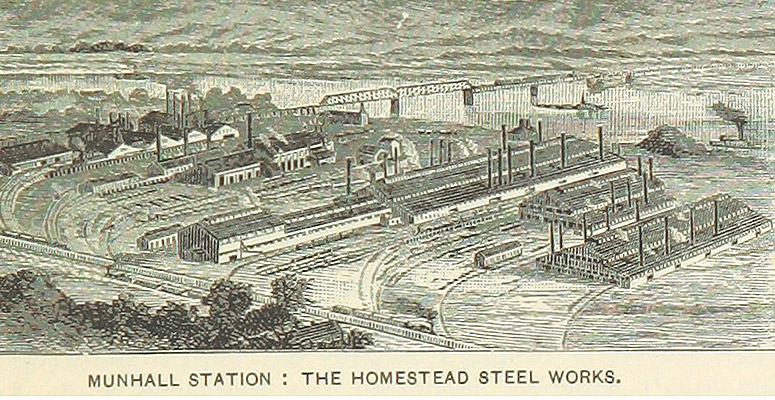
Andrew Carnegie, the son of a handloom weaver, was born in Dunfermline, Scotland, on November 25, 1835. The family had a long radical tradition and his father, William Carnegie, was an active Chartist. His maternal grandfather, Thomas Morrison, had worked with William Cobbett during his campaign for social reform.
The economic depression of 1848 convinced the Carnegie family to immigrate to the United States where they joined a Scottish colony at Allegheny near Pittsburgh. Andrew began work at the age of 12 in a local cotton factory, but continued his education by attending night school.
At 14, Carnegie became a messenger boy in the local Pittsburgh Telegraph Office. His abilities were noticed by Thomas A. Scott, the superintendent of the western division of the Pennsylvania Railroad. He made Carnegie his secretary. During the Civil War, Scott was appointed assistant secretary of war and Carnegie went to Washington to work as his right-hand man. Carnegie's work included organizing the military telegraph system.
After the war, Carnegie succeeded Scott as superintendent of the western division of the Pennsylvania Railroad. Carnegie shrewdly invested in several promising ventures including the Woodruff Sleeping Car Company and several small iron mills and factories. The most important of these was Keystone Bridge, a company which he owned a one-fifth share.
Carnegie made regular visits to Britain where he observed the rapid developments in the iron industry. He was especially impressed by the converter invented by Henry Bessemer. Carnegie realized that steel would now replace iron for the manufacture of heavy goods.
In 1870 Carnegie erected his first blast furnace where he used the ideas being developed by Bessemer in England. Others followed and by 1874 he opened his steel furnace at Braddock. He took several partners, including Henry Frick, but he insisted in retaining the majority holding in his various ventures.
Carnegie took a keen interest in social and political issues and wrote a series of books including Round the World (1881), An American Four-in-Hand in Britain (1883) and Triumphant Democracy (1886), where he compared the egalitarianism of America with the class-based inequalities of Britain and other European countries. He praised America's educational system arguing that: "Of all its boasts, of all its triumphs, this is at once its proudest and its best."
In June 1889, the North American Review published an article by Carnegie on what he called the "Gospel of Wealth." In the article, Carnegie argued that it was the duty of rich men and women to use their wealth to benefit the welfare of the community. He wrote that a "man who dies rich dies disgraced."
In 1889, Carnegie decided to allow Henry Frick to become chairman of the Carnegie Company while he moved to New York to deal with the growing importance of research and development. Carnegie also spent six months of the year in Scotland with his family.
When Frick took control the firm consisted of various mills and furnaces in the Pittsburgh area. Frick was concerned that there was no centralized management structure and so in 1892 all productive units were integrated to form the Carnegie Steel Company. Valued at $25 million it was now the largest steel company in the world.
In an effort to increase profits, Henry Frick decided to lower the piecework wage rate of his employees. In 1892, the Amalgamated Iron and Steel Workers Union called out its members at the Carnegie's Homestead plant. Frick now took the controversial decision to employ 300 strikebreakers from outside the area. The men were brought in on armed barges down the Monongahela River. The strikers were waiting for them and a day long battle took place. Ten men were killed and 60 wounded before the governor obtained order by placing Homestead under martial law.
Carnegie, who was in Scotland during the strike, was furious with Frick as he had instructed him not to use strikebreakers. Carnegie did not criticize Frick in public and as a result, had to take responsibility for what had happened. He later wrote: "I was the controlling owner. That was sufficient to make my name a by-word for years."
The Carnegie Steel Company continued to expand and between 1889 & 1899, production of steel rose from 332,111 to 2,663,412 tons. Profits increased from $2 million to $40 million. There was growing conflict between Carnegie and Henry Frick. This came to a head in 1899 and Carnegie bought out Frick for $15 million.
In 1901, Frick joined with J. Pierpont Morgan to purchase the Carnegie Company for $500,000,000 and established the U.S. Steel Corporation that was valued at $1.4 billion. Carnegie himself now had a personal fortune of $225,000,000.
Carnegie set up a trust fund "for the improvement of mankind." This included the building of 3,000 public libraries (380 in Britain), the Carnegie Institute of Pittsburgh, the Carnegie Institute of Technology and the Carnegie Institution of Washington for research into the natural and physical sciences. Carnegie also established the Endowment for International Peace in an effort to prevent future wars.
By the time Andrew Carnegie died, he had given away $350,000,000. A further $125 million was placed with the Carnegie Corporation to carry on his good works.
Carnegie died in Lenox, Massachusetts on August 11, 1919. He is interred in Sleepy Hollow Cemetery in Sleepy Hollow, New York.
